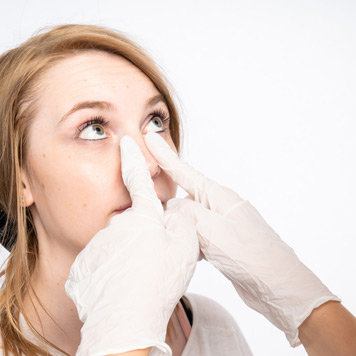Septorhinoplasty
A septorhinoplasty is a surgical procedure done to correct a deviated septum and nasal obstruction. The goals of a septorhinoplasty include improving the appearance of the nose and improving the patient’s ability to breathe.
Symptoms and Causes of a Deviated Septum
Individuals with a deviated septum may experience the following symptoms:

A deviated septum may be caused by an injury to the nose during childbirth, an automobile accident or trauma sustained while playing contact sports, such as wrestling or rough play.
What to Expect During the Procedure
The operation will be performed under general anesthesia and will take one to two hours. The surgeon will begin by making an incision on the mucosa (which is the lining of the inside of the nose) and lifting it off the cartilage and bone. They will then remove excess cartilage and bone and correct the nose positioning by an infracture, which involves breaking and setting the bones. The surgeon may also need to use a cartilage graft, a bone graft or an artificial implant to support or rebuild a part of the nose. If the patient has a hump (or dorsum) on their nose, the surgeon will remove the excess cartilage forming the tip of the nose. At the end of the procedure, the surgeon will pack the inside of the nose with cotton to prevent bleeding, and place a splint and strapping on the outside of the nose for support.
The Recovery Process
Patients will be allowed to go home the same day but will need a driver. Patients may remove the packing in the nose the following day but will need to visit the surgeon one week after the procedure to remove the splint and strapping.
For two weeks, patients should avoid:
Patients undergoing any type of surgical operation, including a septorhinoplasty, may experience the following general complications:
- Bleeding
- Pain
- Infection of the nose
- Blood clot in the leg or lung
Other potential complications specific to a septorhinoplasty include:
- Redness
- Nasal obstruction
- Reduced sense of smell
- A hole in the septum
- Adhesions, where scar tissue forms deep inside the nose and can obstruct airflow
- Bruising and swelling of the nose and under the eyes
- Bleeding caused by infection
- Unsightly scarring of the skin
- Developing a collection of blood (hematoma) or an abscess between the layers of the septum
- Damage to nerves that supply the skin at the tip of the nose
- Toxic shock syndrome, which is an infection of the bloodstream
- Cosmetic problems
- Problems at the donor site if the patient needs a cartilage graft from the ear
- Graft rejection







